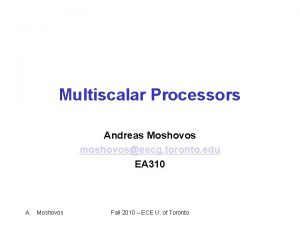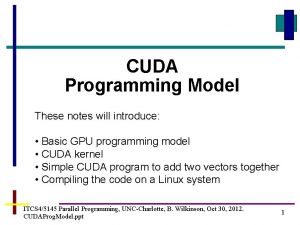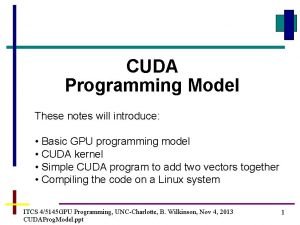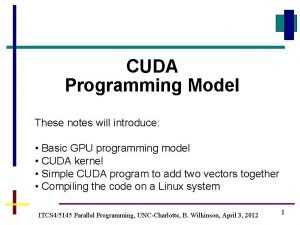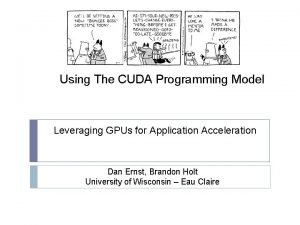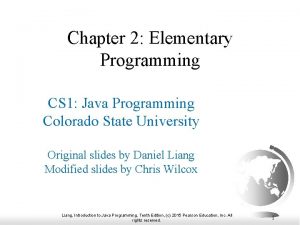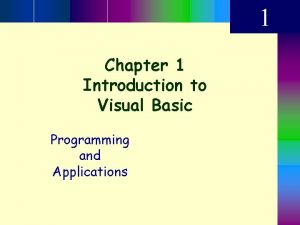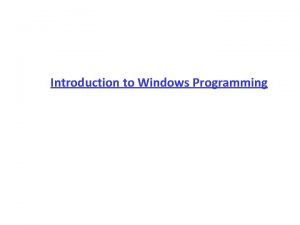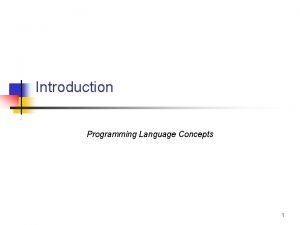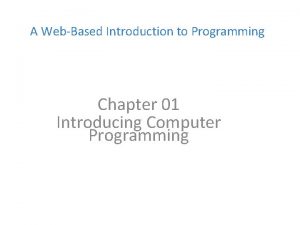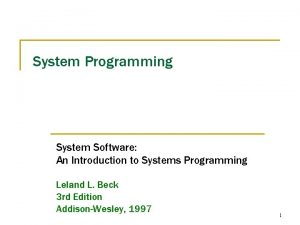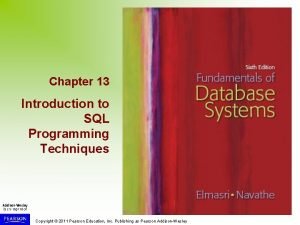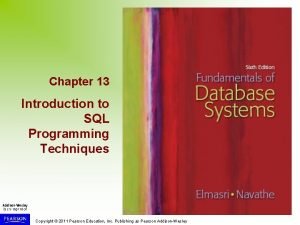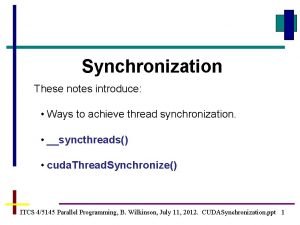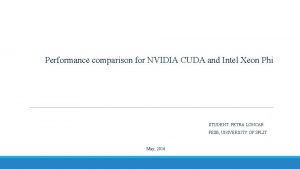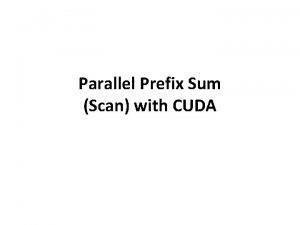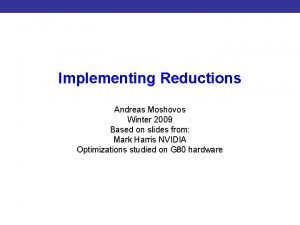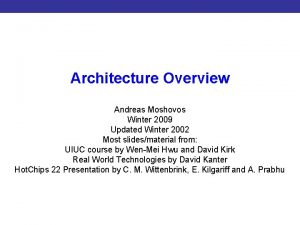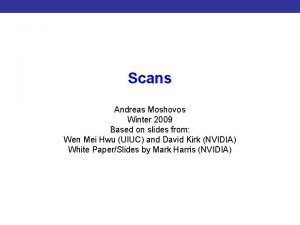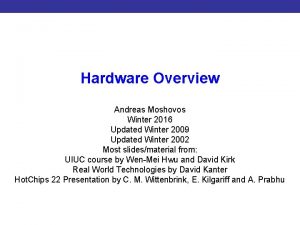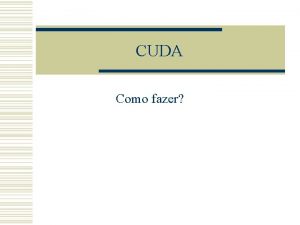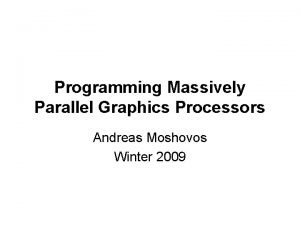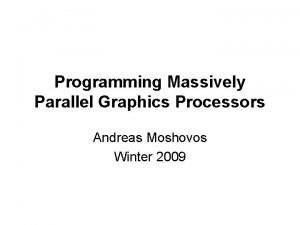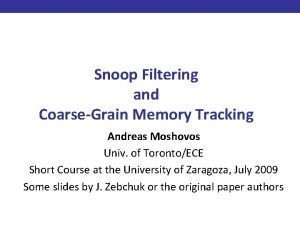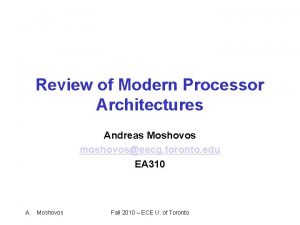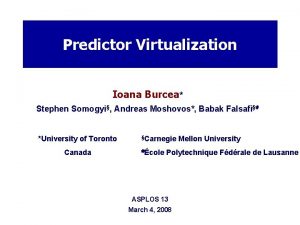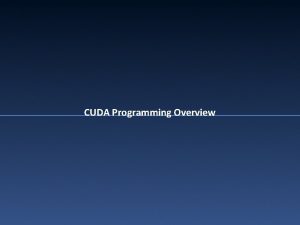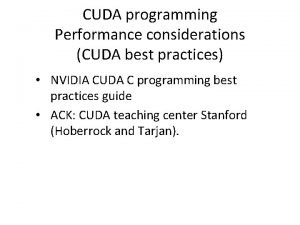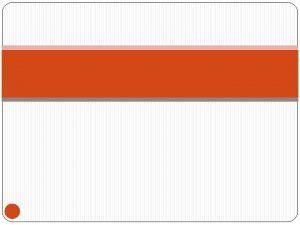CUDA Programming Introduction to CUDA Programming Andreas Moshovos


![Sequential Execution Model int a[N]; // N is large for (i =0; i < Sequential Execution Model int a[N]; // N is large for (i =0; i <](https://slidetodoc.com/presentation_image_h2/bd9e24320aad9951c9c11e2fce4ca02b/image-3.jpg)
![Data Parallel Execution Model / SIMD int a[N]; // N is large for all Data Parallel Execution Model / SIMD int a[N]; // N is large for all](https://slidetodoc.com/presentation_image_h2/bd9e24320aad9951c9c11e2fce4ca02b/image-4.jpg)
![Single Program Multiple Data / SPMD int a[N]; // N is large for all Single Program Multiple Data / SPMD int a[N]; // N is large for all](https://slidetodoc.com/presentation_image_h2/bd9e24320aad9951c9c11e2fce4ca02b/image-5.jpg)




































- Slides: 41

CUDA Programming Introduction to CUDA Programming Andreas Moshovos Winter 2009 Some slides/material from: UIUC course by Wen-Mei Hwu and David Kirk UCSB course by Andrea Di Blas Universitat Jena by Waqar Saleem NVIDIA by Simon Green CUDA By Example Book, David Weller, http: //developer. nvidia. com/content/cuda-example-introduction-generalpurpose-gpu-programming-0

Some things are naturally parallel
![Sequential Execution Model int aN N is large for i 0 i Sequential Execution Model int a[N]; // N is large for (i =0; i <](https://slidetodoc.com/presentation_image_h2/bd9e24320aad9951c9c11e2fce4ca02b/image-3.jpg)
Sequential Execution Model int a[N]; // N is large for (i =0; i < N; i++) time a[i] = a[i] * fade; Flow of control / Thread One instruction at the time Optimizations possible at the machine level
![Data Parallel Execution Model SIMD int aN N is large for all Data Parallel Execution Model / SIMD int a[N]; // N is large for all](https://slidetodoc.com/presentation_image_h2/bd9e24320aad9951c9c11e2fce4ca02b/image-4.jpg)
Data Parallel Execution Model / SIMD int a[N]; // N is large for all elements do in parallel time a[i] = a[i] * fade; This has been tried before: ILLIAC III, UIUC, 1966 http: //ieeexplore. ieee. org/xpls/abs_all. jsp? arnumber=4038028&tag=1 http: //ed-thelen. org/comp-hist/vs-illiac-iv. html
![Single Program Multiple Data SPMD int aN N is large for all Single Program Multiple Data / SPMD int a[N]; // N is large for all](https://slidetodoc.com/presentation_image_h2/bd9e24320aad9951c9c11e2fce4ca02b/image-5.jpg)
Single Program Multiple Data / SPMD int a[N]; // N is large for all elements do in parallel time if (a[i] > threshold) a[i]*= fade; Code is statically identical across all threads Execution path may differ The model used in today’s Graphics Processors

Programmer’s view • GPU as a co-processor (CPU data is from 2008 – matches our lab machines) CPU GPU 3 GB/s – 8 GB. s 177. 4 GB/sec 6. 4 GB/sec – 31. 92 GB/sec 8 B per transfer Memory GPU Memory 1 GB on our systems GTX 480 characteristics Top of the line in 2010 Key Suppliers: Nvidia and AMD

Execution Timeline CPU / Host 1. Copy to GPU mem 2. Launch GPU Kernel time 2’. Synchronize with GPU 3. Copy from GPU mem GPU / Device

Programmer’s view • First create data on CPU memory CPU Memory GPU Memory

Programmer’s view • Then Copy to GPU CPU Memory GPU Memory

Programmer’s view • GPU starts computation runs a kernel • CPU can also continue CPU Memory GPU Memory

Programmer’s view • CPU and GPU Synchronize CPU Memory GPU Memory

Per Kernel Computation Partitioning • Computation Grid: 2 D Case thread Block • Threads within a block can communicate/synchronize – Run on the same multiprocessor • Threads across blocks can’t communicate – Shouldn’t touch each others data – Behavior undefined

Per Kernel Computation Partitioning • Computation Grid: 2 D Case thread Block • One thread can process multiple data elements • Other mappings are possible and often desirable • More on this when we talk about how to optimize for performance

Fade example • Each thread will process one pixel for all elements do in parallel a[i] = a[i] * fade;

Code Skeleton • CPU: – Initialize image from file – Allocate IN and OUT buffers on GPU – Copy image to – Launch GPU kernel • Reads IN • Produces OUT – Copy Out back to CPU – Write image to a file • GPU: – Launch a thread per pixel

GPU Kernel pseudo-code __global__ void fade (unsigned char *in, unsigned char *out, float f, int xmax, int ymax) { unsigned int v = in[x][y]; v = v * f; if (v > 255) v = 255; out[x][y] = v; } • This is the program for one thread • It processes one pixel

How does a thread know which pixel to process? grid. Dim. x block. Dim. x thread. Idx. x block. Dim. y block. Idx. x thread. Idx. y grid. Dim. y

• grid. Dim. x = 7, grid. Dim. y = 6 • How many blocks per dimension

block. Dim • block. Dim. x= 7, block. Dim. y = 7 • How many threads in a block per dimension

block. Idx • block. Idx = coordinates of block in the grid • block. Idx. x = 2, block. Idx. y = 3 • block. Idx. x = 5, block. Idx. y = 1 (0, 0)

thread. Idx • thread. Idx = coordinates of thread in the block • threadidx. x= 2, thread. Idx. y = 3 • thread. Idx. x = 5, thread. Idx. y = 4 (0, 0)

How does a thread know which pixel to process? grid. Dim. x block. Dim. x thread. Idx. x block. Dim. y block. Idx. x thread. Idx. y grid. Dim. y x = block. Idx. x * block. Dim. x + thread. Idx. x y = block. Idx. y * block. Dim. y + thread. Idx. y

GPU Kernel pseudo-code __global__ void fade (unsigned char *in, unsigned char *out, float f, int xmax, int ymax) { int x = block. Dim. x * block. Idx. x + thread. Idx. x; int y = block. Dim. y * block. Idx. y + thread. Idx. y; unsigned int v = in[x][y]; v = v * f; if (v > 255) v = 255; out[x][y] = v; }

GPU Kernel pseudo-code w/ limits __global__ void fade (unsigned char *in, unsigned char *out, float f, int xmax, int ymax) { int x = block. Dim. x * block. Idx. x + thread. Idx. x; int y = block. Dim. y * block. Idx. y + thread. Idx. y if ( (x >= xmax) || (y>= ymax) ) return; unsigned int v = in[x][y]; v = v * f; if (v > 255) v = 255; out[x][y] = v; }

Convert to a unidimensional array __global__ void fade (unsigned char *in, unsigned char *out, float f, int xmax, int ymax) { int x = block. Dim. x * block. Idx. x + thread. Idx. x; int y = block. Dim. y * block. Idx. y + thread. Idx. y int offset = y * (block. Dim. x * grid. Dim. x) + x; if ( (x >= xmax) || (y>= ymax) ) return; unsigned int v = in[offset]; v = v * f; if (v > 255) v = 255; out[offset] = v; }

PPM images typedef struct ppm_t { unsigned char *rgb; unsigned int x, y, d; } ppm_t; P 3 1024 768 255 0 0 … 255 0 Every pixel has three values RGB 0 0 255

Main program int main( int argc, char** argv) { ppm_t *image = ppmread ("Untitled. ppm"); float f = 1. 5; int pixels = image->x * image->y * 3; int threads = 256; int blocks = (pixels / threads) + ((pixels % threads) ? 1: 0);

Main Program contd. cuda. Malloc ((void**) &din, pixels); cuda. Malloc ((void**) &dout, pixels); cuda. Memcpy (din, image->rgb, pixels, cuda. Memcpy. Host. To. Device) ; fade <<<blocks, threads>>> (din, dout, f, pixels); cuda. Memcpy (image->rgb, dout, pixels, cuda. Memcpy. Device. To. Host) ;

Main Program contd. • • ppmwrite ("out. ppm", image); ppmfree (image); cuda. Free(din); cuda. Free(dout);

Fade Kernel __global__ void fade (unsigned char *in, unsigned char *out, float f, int pixels) { int x. Index = block. Idx. x * block. Dim. x + thread. Idx. x; if (x. Index >= pixels) return; unsigned char *t = in + x. Index; unsigned int v = *t; v = v * f; if (v > 255) v = 255; t = out + x. Index; *t = v; }

Execution order? • • • Not defined Threads may run: All in parallel One after the other Any other order • • On GPU hardware they run in groups of 32 This is called a WARPS: threads 0 -31, 32 -63, … No order defined among WARPS

Drawing a fractal

Drawing a Fractal • Julia Set • Compute: • Where Z is a complex number • Z belongs in the set if the function remains bounded • If the function grows toward infinity, Z is not in the set

CPU Julia Kernel void kernel (unsigned char *image) { for (int y=0; y<DIM; y++) { for (int x=0; x<DIM; x++) { int offset = (x + y * DIM) * 3; int julia. Value = julia ( x, y ); image[offset + 0] = 255 * julia. Value; image[offset + 1] = 0; image[offset + 2] = 0; } } }

Julia Function

Complex Numbers

GPU Kernel __global__ void kernel( unsigned char *ptr ) { int x = block. Idx. x * block. Dim. x + thread. Idx. x; int y = block. Idx. y * block. Dim. y + thread. Idx. y; int offset = (x + y * grid. Dim. x * block. Dim. x) * 3; // now calculate the value at that position int julia. Value = julia( x, y ); ptr[offset + 0] = 255 * julia. Value; ptr[offset + 1] = 0; ptr[offset + 2] = 0; }

Julia function __device__ __host__int julia( int x, int y ) { const float scale = 1. 5; float jx = scale * (float)(DIM/2 - x)/(DIM/2); float jy = scale * (float)(DIM/2 - y)/(DIM/2); cu. Complex c(-0. 8, 0. 156); cu. Complex a(jx, jy); int i = 0; for (i=0; i<200; i++) { a = a * a + c; if (a. magnitude 2() > 1000) return 0; } return 1; }

Complex numbers struct cu. Complex { float r; float i; __device__ cu. Complex( float a, float b ) : r(a), i(b) {} __device__ float magnitude 2( void ) { return r * r + i * i; } __device__ cu. Complex operator*(const cu. Complex& a) { return cu. Complex(r*a. r - i*a. i, i*a. r + r*a. i); } __device__ cu. Complex operator+(const cu. Complex& a) { return cu. Complex(r+a. r, i+a. i); } };

Main program int main( void ) { ppm_t *image = ppmalloc (DIM, 255); int pixels = image->x * image->y * 3; unsigned char *dout; cuda. Malloc( (void**)&dout, pixels ); dim 3 grid(DIM/16, DIM/16); dim 3 block(16, 16); kernel <<<grid, block>>> ( dout ); cuda. Memcpy ( image->rgb, dout, pixels, cuda. Memcpy. Device. To. Host ); ppmwrite ("out. ppm", image); cuda. Free (dout ); ppmfree (image); }

How to set the CUDA environment • ug 51. eecg. toronto. edu through ug 75 • Will be posting instructions on my website • www. eecg. toronto. edu/~moshovos/CUDAsumm er 12
 Andreas moshovos
Andreas moshovos Cuda programming model
Cuda programming model Cuda programming model
Cuda programming model Cuda
Cuda Cuda programming model
Cuda programming model Perbedaan linear programming dan integer programming
Perbedaan linear programming dan integer programming Greedy programming vs dynamic programming
Greedy programming vs dynamic programming What is in system programming
What is in system programming Linear vs integer programming
Linear vs integer programming Definisi integer
Definisi integer Introduction to server side programming
Introduction to server side programming Problem solving
Problem solving Introduction to programming languages
Introduction to programming languages Daniel liang introduction to java programming
Daniel liang introduction to java programming An introduction to parallel programming peter pacheco
An introduction to parallel programming peter pacheco Introduction to visual basic
Introduction to visual basic Plc stands for
Plc stands for Programming and problem solving with java
Programming and problem solving with java Introduction to windows programming
Introduction to windows programming Programming language
Programming language Csc 102
Csc 102 A web based introduction to programming
A web based introduction to programming Sic programming examples
Sic programming examples Computer programming chapter 1
Computer programming chapter 1 C programming and numerical analysis an introduction
C programming and numerical analysis an introduction Introduction to visual basic programming
Introduction to visual basic programming Scratch programming concepts
Scratch programming concepts Python programming an introduction to computer science
Python programming an introduction to computer science Java introduction to problem solving and programming
Java introduction to problem solving and programming History of python
History of python Introduction to java programming 10th edition quizzes
Introduction to java programming 10th edition quizzes Introduction to sql programming techniques
Introduction to sql programming techniques Introduction to sql programming techniques
Introduction to sql programming techniques Chapter 1 introduction to computers and programming
Chapter 1 introduction to computers and programming C programming chapter 1
C programming chapter 1 Cuda texture object example
Cuda texture object example Texture memory cuda
Texture memory cuda Syncthreads
Syncthreads Sedam svetskih cuda
Sedam svetskih cuda Petra loncar
Petra loncar Cuda exclusive scan
Cuda exclusive scan Rbg pixel
Rbg pixel
